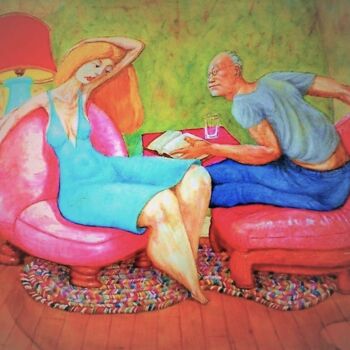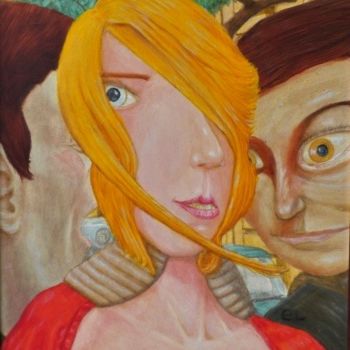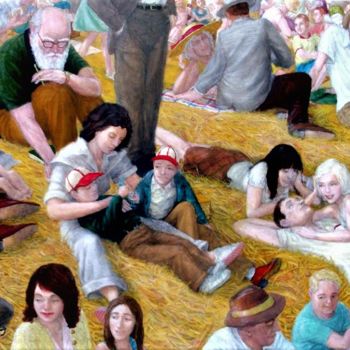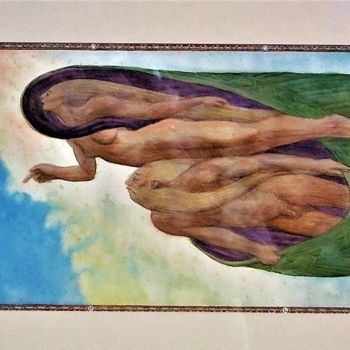Venus Emerges (2022) Drawing by Edwin Loftus
More info
- Packaging (Envelope) All artworks are shipped with a premium carrier, carefully protected and insured.
- Tracking Order tracking until the parcel is delivered to the buyer. A tracking number will be provided so that you can follow the parcel in real-time.
- Delay Worldwide delivery in 3 to 7 days (Estimate)
More info
- Trackable Online Certificate of Authenticity Authenticity Certificates can be verified online at any moment by scanning the artwork code.
- Artist Value Certification Experts study the work and career of an artist then establish an independent and reliable average price value. The average price value situates the artist on a price range for a given period. The experts may also be asked to establish a more precise estimate for a particular work.
More info
100% secure payment with SSL certificate + 3D Secure.
More info
This image is available for download with a licence
Seller Edwin Loftus
-
Original Artwork (One Of A Kind)
Drawing,
Pastel
on Cardboard
- Dimensions Height 14in, Width 11in
- Artwork's condition The artwork is in perfect condition
- Framing This artwork is not framed
- Categories Drawings under $5,000 Symbolism
In most ancient civilizations of which we have written records, males were the economic and political center of the family and social order. Views differed greatly from culture to culture, but women, were often viewed as a form of inferior part of humanity, entitled to protection, sometimes with very important rights that verged on superiority in the right settings, but often as possessions of the males with authority over them. Systems equivalent to bride prices and dowries existed around the world.
A bride price, is the sales value of a daughter, usually paid to her father for the right to make her a man's wife. This doesn't mean that a daughter did not have value as a family member and as a person. in fact, for those reasons and her value as a worker in the household and business, fathers, as the controllers of the household, were considered to be owed compensation for the loss they would incur. The family was still likely to take into account the ability of the payee to provide a secure home for their daughter and to treat her humanely. A man of ill-repute might well be turned down, even if he exceeded the bride price asked.
A dowry is the treasure a daughter brings with her as her own possessions and sometimes a sweetener to the exchange of custody. A wealthy daughter's dowry might include large sums of cash and land of economic value. Dowries might be frittered away, but they have often been the property of the wife, protected in case of divorce or inheritance disputes upon the husband's death. A second form of dowry is the 'bride price' a father pays the husband and his family to take on the expense of keeping his daughter. Failure to pay as promised or paying what the family thought too little could place the bride in jeopardy of being cast out or killed.
A third form of bride selling were marriages of alliance. The joining of two families' bloodlines could form a bond of cooperation or non-aggression, the latter particularly of interest to kings and their kinfolk.
In this sort of context and its many variations, romantic interest was expected to result from the marriage, rather than the other way around. And of course, there were many instances of romantic attractions forming between persons other than the person's spouse.
Romantic love was a plus when it occurred between married people, and a bane to social order otherwise, particularly when it led to infidelity and either the production of unwanted children or interfered with the production of heirs. In Europe the rebirth of importance of romantic love began during the Renaissance and into the Enlightenment, generalized through the media of songs, plays, and romantic literature, the mass-media of their day.
Plays like, Romeo and Julliet, were slightly scandalous and very appealing because exposed the alternative and its potential tragedy in a world in which The Taming of the Shrew was just as understandable. Even today, there are countries where bride-selling and dowries that purchase the security of the bride are still practiced and there are those among us that believe couples should be matched based on economic or genetic characteristics. Over the last few decades dozens (or more) movies have been released based on the premise that if someone doesn't get married soon, they'll lose their inheritance. These films are successful because the person they choose as a fake spouse always ends up being their true romantic partner, but the interesting thing is that such stories stand so perfectly with one foot in the pre-romantic era and one foot in the romantic era, and people all over the world accept the premise, because those people are rich and have so much more riding on such things, (no one cares if a pauper or middle-class shop owner's son is denied their inheritance).
A few centuries of infatuation with romance is far from a foundation for an argument that the world has changed. But a few millennia of romantic tales that excite our imaginations and yearnings are an argument for a benefit to be had if and when such a change occurs.
My personal belief is that mutual sexual attraction and mutual romantic attraction are like the two ends of an arrow. The "point" of sexual attraction leads us there and enables us to stick with our target. But the fletching of romantic attraction is what guides us to the right target and the part that remains visible long after the point has done its job.
That is why I have done so many drawings on this subject and tend to mix sex and the potential for love in them. Like Jack and Jill, they'll go up the hill and will either return with a pail of water between them or will come tumbling down.
Related themes
Edwin Loftus is an American painter and draftsman born in 1951. His interest in art began at the age of 4 when he decided to draw something real rather than working from his imagination.
As a child he excelled at drawing and as a teenager he began to experiment with oil painting. In college, he took courses in art and art history and realized that true art had nothing to do with the quality of the drawing or painting, but that it had to have the ambition to push the boundaries and expand the visual experience.
He also studied philosophy, psychology and history and quickly realized that it was just another art establishment trying to defend its elitist industry and reward system. Their skills were almost non-existent, they knew nothing about psychology, perception or stimulus response, and they were extensions of the belief system that made communism, fascism and other forms of totalitarianism such destructive forces in the world. They literally believe that art shouldn't be available to ordinary human beings, but only to an elite "sophisticated" enough to understand it.
Edwin Loftus realized that the emperors of art had no clothes, but they were still the emperors. Gifted in art, he worked hard to acquire this skill. So he found other ways to make a living and sold a few artworks from time to time. For sixty years, many people enjoyed his works and some collected them.
Today, Edwin Loftus is retired. Even if he sold all his paintings for the price he asked, "artist" would be the lowest paid job he ever had... but that's the way it is. It won't matter to him after he dies. He just hopes that some people will like what he does enough to enjoy it in the future.
-
Nationality:
UNITED STATES

- Date of birth : 1951
- Artistic domains: Works by artists with a certified artist value,
- Groups: Certified Artists Contemporary American Artists








